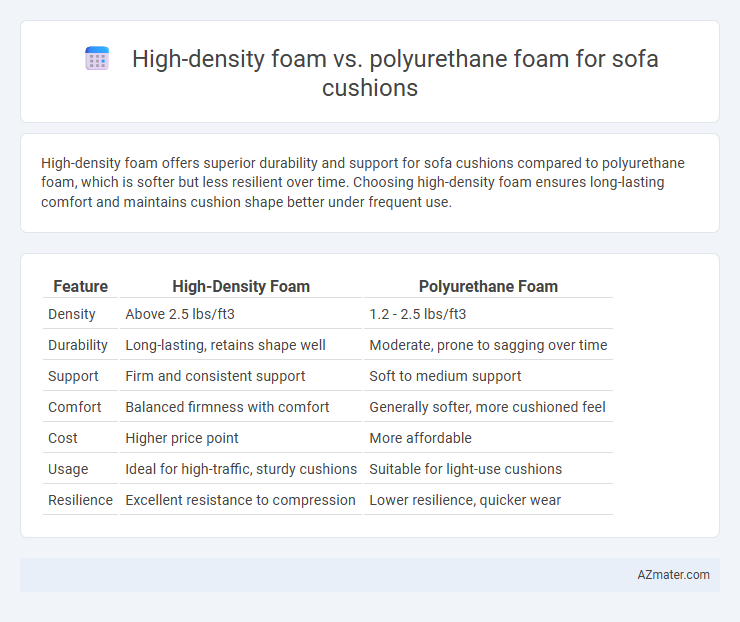High-density foam offers superior durability and support for sofa cushions compared to polyurethane foam, which is softer but less resilient over time. Choosing high-density foam ensures long-lasting comfort and maintains cushion shape better under frequent use.
Table of Comparison
| Feature | High-Density Foam | Polyurethane Foam |
|---|---|---|
| Density | Above 2.5 lbs/ft3 | 1.2 - 2.5 lbs/ft3 |
| Durability | Long-lasting, retains shape well | Moderate, prone to sagging over time |
| Support | Firm and consistent support | Soft to medium support |
| Comfort | Balanced firmness with comfort | Generally softer, more cushioned feel |
| Cost | Higher price point | More affordable |
| Usage | Ideal for high-traffic, sturdy cushions | Suitable for light-use cushions |
| Resilience | Excellent resistance to compression | Lower resilience, quicker wear |
Introduction to Sofa Cushion Foams
High-density foam and polyurethane foam are essential materials used in sofa cushions, each offering distinct comfort and durability characteristics. High-density foam provides superior support and maintains its shape longer, making it ideal for frequently used furniture. Polyurethane foam, while generally softer and more affordable, tends to compress more quickly, affecting overall cushion resilience and longevity.
What is High-Density Foam?
High-density foam is a type of polyurethane foam characterized by its higher weight per cubic foot, typically ranging from 1.8 to 2.8 pounds, which results in superior durability and support for sofa cushions. This foam offers enhanced resilience, maintaining its shape and firmness longer than lower-density polyurethane foams, making it ideal for heavy-use seating. Its closely packed cells provide better weight distribution and comfort, reducing the risk of sagging over time compared to standard polyurethane foam options.
What is Polyurethane Foam?
Polyurethane foam is a versatile, synthetic material widely used in sofa cushions for its balance of comfort, durability, and affordability. It consists of polymer chains that create a network of flexible cells, offering varying firmness levels depending on its density and formulation. Unlike high-density foam, polyurethane foam provides a softer feel but may compress more quickly over time, making it suitable for those prioritizing initial comfort over long-term support.
Key Differences Between High-Density and Polyurethane Foam
High-density foam for sofa cushions offers superior durability and support due to its higher density, typically above 1.8 pounds per cubic foot, compared to standard polyurethane foam, which ranges from 1.2 to 1.8 pounds per cubic foot and tends to soften and degrade faster. High-density foam resists sagging and maintains shape longer, making it ideal for long-term use, while polyurethane foam provides a softer feel but lacks the resilience required for heavy or frequent use. The breathability and firmness of high-density foam generally enhance comfort and longevity, whereas polyurethane foam is more affordable but may require more frequent replacement.
Comfort and Support: Which Foam Performs Better?
High-density foam offers superior support and durability for sofa cushions, maintaining its shape and firmness over time, which enhances overall comfort by preventing sagging. Polyurethane foam provides a softer, more cushioned feel initially but tends to compress and lose support faster, making it less ideal for long-term comfort and support. For users prioritizing sustained comfort and structural integrity, high-density foam outperforms polyurethane foam in both support and long-lasting comfort.
Durability and Longevity Comparison
High-density foam offers superior durability and longevity for sofa cushions due to its greater resilience and ability to retain shape over time compared to standard polyurethane foam. Polyurethane foam, while initially softer and more affordable, tends to compress and degrade faster under regular use, resulting in diminished support and comfort. Investing in high-density foam cushions reduces the frequency of replacements and maintains seating comfort longer, making it a cost-effective choice for long-term furniture performance.
Cost Analysis: High-Density vs Polyurethane Foam
High-density foam typically costs more than standard polyurethane foam due to its superior durability and support, making it a worthwhile investment for long-term use in sofa cushions. Polyurethane foam, while more affordable upfront, tends to compress and lose shape faster, possibly leading to higher replacement costs over time. Evaluating the balance between initial expense and lifespan helps determine the most cost-effective choice for sofa cushioning.
Maintenance and Care Considerations
High-density foam cushions offer superior durability and resistance to sagging, requiring less frequent fluffing and reshaping compared to polyurethane foam. Polyurethane foam cushions may compress faster and demand regular rotation and occasional replacement to maintain comfort and support. Both types benefit from protection against moisture and direct sunlight to extend their lifespan and prevent degradation.
Best Uses for Each Foam Type in Sofa Cushions
High-density foam provides firm support and excellent durability, making it ideal for sofa cushions that experience heavy daily use or require shape retention. Polyurethane foam offers a softer, more flexible cushioning suitable for casual seating or decorative pillows where comfort and affordability are prioritized. Choosing high-density foam benefits structured sofas needing long-term resilience, whereas polyurethane foam suits loungers emphasizing plushness and initial comfort.
Conclusion: Choosing the Right Foam for Your Sofa
High-density foam offers superior durability and support, making it ideal for sofa cushions that require long-lasting comfort and shape retention. Polyurethane foam provides a more affordable, softer option but may compress faster and lose resilience over time. Selecting the right foam depends on balancing budget constraints with desired firmness, longevity, and usage frequency of the sofa.

Infographic: High-density foam vs Polyurethane foam for Sofa cushion
 azmater.com
azmater.com